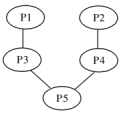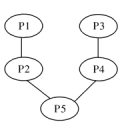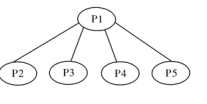1 . As the world’s oldest living organisms, trees have been our silent companions. Although they inspire a large quantity of fancy tales, the richness of what they say is beyond description.
The German forester Peter Wohlleben spent decades working and learning their secrets. Feelings are rarely applied to trees, but Wohlleben has done so without hesitation. According to Wohlleben, that humans do not speak the trees’ language does not mean they do not communicate. Trees are badly misunderstood even if they communicate with chemical and electrical signals.
Wohlleben claims that trees are creatures as human beings. In one of 50 cases, Wohlleben’s team sees the special friendships between trees, as they can distinguish between one individual and another. This means that trees do not treat all other trees the same. For instance, Wohlleben saw two old beeches standing next to each other. Compared to the usual case, each one growing its branches turned away from the other rather than toward each other. This kind of partnership is well-known to foresters. They know that such tree pairs are really like a human couple. If they chop one down, they need to chop down both because the other will die anyway.
Trees were also found to keep each other alive in different ways. They pass food to nearby sick trees and send signals to warn others of dangerous insects. In one of his investigations, Wohlleben also discovered a beech tree cut about 400 to 500 years ago. The trunk is still alive and was found with green chlorophyll (叶绿素) under the thick bark. Since it has no leaves to create sugar, the only explanation is that neighbouring trees have supported this tree for more than centuries.
The trees that suffered through drought were found to consume less water in the spring so that they will have more water available in the summer months. This implies that a tree can learn and remember a drought its whole life, acting on that memory by being more cautious about its water consumption.
1. What is the function of the first paragraph?| A.To arouse readers’ interest. | B.To introduce a topic. |
| C.To present a new discovery. | D.To demonstrate a heated debate. |
| A.Trees communicate in the same way as humans. |
| B.Trees can’t tell friends and enemies apart. |
| C.Trees are loyal to their partners. |
| D.Trees can keep each other alive within limited periods. |
| A.Because they have more water available in summer |
| B.Because they have suffered through drought before. |
| C.Because they don’t need so much water in the spring. |
| D.Because they can depend on the support from other trees. |
| A.Mysteries of trees are unfolded | B.Trees are our silent companions |
| C.Trees can adapt to the environment | D.Trees can form special relationships |
2 . This is the time of year when many gardeners are harvesting tomatoes. Gardening expert Jessica Damiano recently reported about the many pictures of strangely shaped tomatoes sent to her from fans of her gardening advice.
Not every tomato on an affected plant will be deformed (改变形状), however. What are the possibilities? Under the right conditions (temperatures that are too hot or even too cold), this could affect one or two tomatoes per plant, depending on where they are in the development process and what the (weather) conditions are, said Timothy McDermott, a professor at Ohio State University. The possibility of one of your tomatoes developing a locule oddity (怪异) is about one in a thousand, McDermott said.
And, when harvesting your crop, remember:
| A.select the good-looking ones. |
| B.Any tomato can grow an extra locule. |
| C.the funny-looking tomatoes taste just as good! |
| D.What causes the unusual appearance of tomatoes? |
| E.Unless otherwise diseased, they are perfectly good for eating. |
| F.She said people sometimes question if the tomatoes are okay to eat. |
| G.Provide shade for your plants when temperatures are predicted to remain above 32℃. |
Science on Sundays is a programme of free monthly science talks which always brings the latest discoveries in plant science, as well as research linked to the plant collection at the Botanic Garden, to the visitors in a 30-minute short period of time. The programme in April is about tulips(郁金香).
Introduction
Time: 2:30 pm on Sundays
Title: In Search of Wild Tulips
Objects: adults and children aged 12+
Speaker: Brett Wilson at University of Cambridge
Background Information
The planted tulips are a common sight in spring gardens around the world, but have you ever considered where wild tulips grow? The wild ancestors of our much-loved gardening varieties can mostly be found in the mountains and valleys of Central Asia, far from the Netherlands, where most tulips are grown and bred. At the Botanic Garden, we have a National Tulip Collection where we grow many wild species including plenty of species from Central Asia. Over the last four years, Brett Wilson has been using something learned from books and combining with fieldwork to understand the diversity of tulips, with a view of identifying which species are most at risk of extinction.
Come and listen to Brett speak about the research and the adventures that have occurred in our search to find and protect wild tulips in this remote corner of the world. These will be live face-to-face talks taking place in the Botanic Garden Classroom for those visitors with interest.
1. What do we know about Science on Sundays?| A.It focuses on plants. |
| B.It is a paid programme. |
| C.It appeals only to children. |
| D.It is a live broadcast on weekdays. |
| A.By making assumptions. |
| B.By picking and collecting tulips. |
| C.By growing tulips in greenhouses. |
| D.By combining theory and practice. |
| A.To ask visitors to plant more tulips. |
| B.To call on visitors to listen to the talks. |
| C.To push visitors to take more botany classes. |
| D.To advise visitors to take adventure in remote areas. |
Picking tea leaves is
China has been a big tea producing country since ancient times. According to official data, China’s tea planting area
In spring, local hillsides are often filled with tea pickers as well as farmers
5 . Can plants talk? Modern research has found something amazing: they do communicate with each other.
It has been known for some time that plants use chemicals to communicate with each other. This happens when a plant gets attacked by insects. The plant gives out chemicals from the leaves that are being eaten. This is like a warning, or a call for help: "I'm being attacked! " When another plant gets the chemicals, it starts to give out its own, different chemicals. Some of these chemicals drive insects away. Others attract the wasps(黄蜂;蜜蜂)! The wasps kill the insects that are eating the plants. Scientists hope to learn more about this plant warning system, so that we can use it to grow more crops.
More surprisingly, plants also use sound to communicate. People can't hear these sounds ; but plants are making them. Some plants make noises with their roots. Corn and chili plants do this. Some trees make clicking noises when there is not enough water.
Most surprisingly of all, plants have an amazing system of communication that can link nearly every plant in a forest. Scientists call this system the “ wood wide web”. The wood wide web is linked underground by fungi(霉菌).It links the roots of different plants to each other. It is in some ways similar to the Internet we use. Using the wood wide web, plants can share information and even food with each other. However, it may lead to bad effects. Plants may use it to steal food from each other, or spread chemicals to attack other plants. Perhaps one day scientists will learn how to create a “firewall“ to help prevent these attacks within the wood wide web.
Scientists are learning more every day about the secret ways in which plants talk to each other. Maybe one day we will know enough about plant communication to be able to "talk” with them ourselves.
1. What will plants do when they are attacked by insects?| A.They will kill the insects by themselves. |
| B.They will control the wasps to kill the insects. |
| C.They will send out signals to ask for help. |
| D.They will produce chemicals as a warning or a call for help. |
| A.By making noises with their roots. |
| B.By connecting the roots of different plants to each other. |
| C.By sharing food and information with each other. |
| D.By spreading chemicals to each other. |
A. | B. |
C. | D. |
4. Which is the best title for the passage?
| A.The Secret Language of Plants |
| B.The Study About the Plant Warning System |
| C.The Plants that Give Warnings |
| D.Why Scientists Do Research About Plants |



